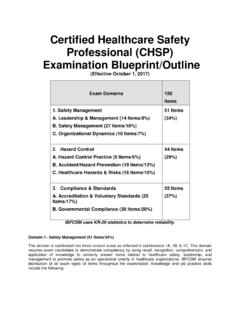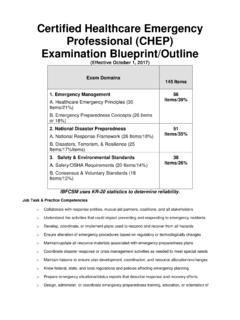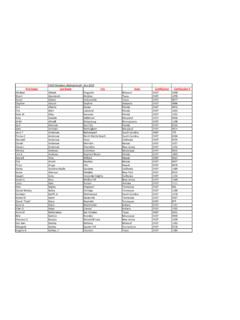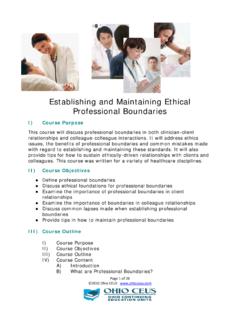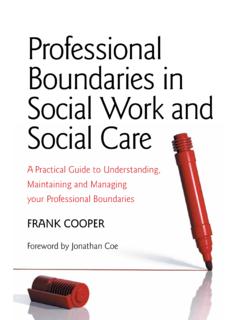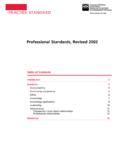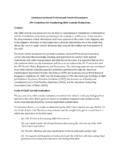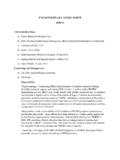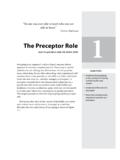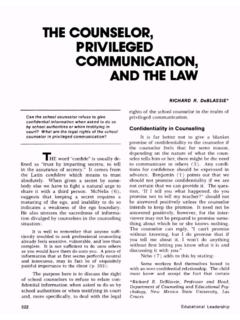Transcription of Certified Emergency & Disaster Professional (CEDP ...
1 Certified Emergency & Disaster Professional ( cedp ) examination blueprint /Outline (Effective October 1, 2017) Exam Domains 145 Items 1. Emergency Management A. Emergency Fundamentals (23 Items or16%) B. Emergency and Disaster Management (32 Items or 22%) 55 Items/ 38% 2. Disaster Preparedness A. National Response Framework (30 Items or 21%) B. Disasters, Terrorism, & Resilience (21 Items or 14%) 51 Items/ 35% 3. Safety & Environmental A. Safety and OSHA Requirements (24 Items or 17%) B. Compliance & Voluntary Standards (15 Items or10%) 39 Items/ 27% IBFCSM uses KR-20 statistics to determine reliability. Job Practice Competencies Collaborate with officials to conduct damage assessments following disasters or emergencies Collaborate with response entities, mutual aid partners, coalitions, and all stakeholders Conduct hazard vulnerability surveys to determine Emergency related risks and hazards Coordinate Disaster response or crisis management activities as needed to meet special needs Coordinate with agencies, hospitals, and other institutions as needed to determine capabilities Design, administer, or coordinate Emergency preparedness training, education.
2 Or orientation Develop Professional working relationships with other Emergency management personnel Develop, coordinate, or implement plans used to respond and recover from all hazards Ensure alteration of Emergency procedures based on regulatory or technologically changes Evaluate Emergency management plans in accordance with state and federal regulations Know federal, state, and local regulations and policies affecting Emergency planning Maintain liaisons to ensure plan development, coordination, and resource allocation/exchanges Maintain/update all resource materials associated with Emergency preparedness plans Prepare Emergency situational/status reports that describe response and recovery efforts Understand the activities that could impact preventing and responding to Emergency incidents Domain 1 Emergency Management (55 Items/38%) This domain requires exam candidates to demonstrate competency by using recall and recognition, comprehension, and application of knowledge to correctly answer items related to Emergency and Disaster management.
3 Exam items appear throughout the examination . Exam items are distributed throughout the examination . Knowledge and job practice skills include the following: a. Design, implement, and maintain comprehensive management systems by defining Emergency preparedness requirements including the development of policies, procedures, and plans. b. Implement policies, procedures, and directives in systematic manner to support requirements to respond to declared emergencies or Disaster events. c. Determine the effectiveness of Emergency related function and relevant systems using collaboration and communication to coordinate operations.
4 D. Apply sound management and leadership concepts practices to efficiently use resources to improve all Emergency and Disaster preparedness functions. e. Use appropriate methods that will ensure stake-holders understand their roles in formulation, coordination, and implementation of Emergency preparedness actions. f. Present and coordinate information with response organizations, government agencies, incident command structures, management, contractors, vendors, and the public. Domain 1A: Emergency Fundamentals (23 Items/16%) 1. Disaster preparedness/response 2. Emergency management 3.
5 Emergency planning 4. Emergency planning & coordination 5. Emergency planning techniques 6. Emergency preparedness 7. Federal agency responsibilities 8. Hazard analysis 9. Healthcare Emergency management requirements 10. Leadership and decision making 11. Leadership and management 12. Medical resources/systems 13. Medical services 14. Medical support concepts 15. Medical treatment planning 16. National preparedness 17. Organizational communication 18. Preparedness risks 19. Resource acquisition 20. Response sector collaboration 21. Supply chains and resources 22. Sustaining response operations 23. System methods and processes Domain 1B: Emergency & Disaster Management (32 Items/22%) 1.
6 Planning coordination 2. Agency coordination/collaboration 3. Authority and responsibility 4. Coalitions 5. Communications 6. Coordinating response actions 7. Disaster recovery 8. Disaster response actions 9. Drills and exercises 10. Emergency coordination 11. Emergency management models 12. Emergency planning effectiveness 13. Emergency supplies 14. Exercises and drills 15. FEMA defined terms 16. Governmental agency coordination 17. Healthcare Emergency management standards 18. Human resource management 19. Identifying hazards 20. Incident command terms 21. Incident command situations 22. Incident command systems 23.
7 Information and data management 24. Lessons learned 25. Mitigation analysis 26. Mitigation and recovery 27. Natural risks and hazards 28. Operational planning 29. Organizational continuity 30. Organizational structures 31. Response assistance and cooperation 32. Warnings and alerts Domain 2 Disaster Preparedness (51 Items/35%) This domain requires exam candidates to demonstrate competency by using recall and recognition, comprehension, and application of knowledge to correctly answer items related to Disaster preparedness. Exam items are distributed throughout the examination . Practice skills include the following: a.
8 Evaluate facilities, products, systems, equipment, and processes by applying qualitative techniques to ensure proper planning, protection, response, mitigation, and recovery during emergencies. b. Recommend actions to minimize hazards and reduce risks posed during emergencies or disasters. c. Evaluate and coordinate response actions with appropriate agencies, institutions, coalitions, and others to ensure the feasibility, effectiveness, and reliability of healthcare operations to support all types of incidents. d. Implement strategies by using the results of hazard identification actions, risk analyses, planning, and coordination to reduce the impact of disasters on healthcare operations to provide care.
9 E. Obtain compliance certifications, listings, approvals or authorizations by identifying applicable regulations, and standards to ensure facility and community Emergency preparedness effectiveness. f. Communicate Emergency and Disaster related hazards, risks, and control measures to employees, management, vendors, and the public. Domain 2A National Response Concepts (30 Items/21%) 1. Assessing natural and man-made hazards 2. Command and control 3. Coordination among agencies 4. Disaster command and control 5. Disaster readiness 6. Disaster response actions 7. Disaster response planning 8.
10 Emergency response support 9. Emergency support function responsibilities 10. Federal agency capabilities 11. Federal agency responsibilities 12. Federal response structure and commands 13. Federal response structures 14. FEMA core capabilities 15. FEMA defined sector capabilities 16. Information technology 17. Infrastructure security and resilience 18. Management and authority models 19. Mass care issues 20. National incident planning 21. National preparedness 22. National preparedness and response 23. Natural Disaster risks 24. Protecting infrastructures 25. Resource delivery effectiveness 26. Sector drills and exercises 27.
